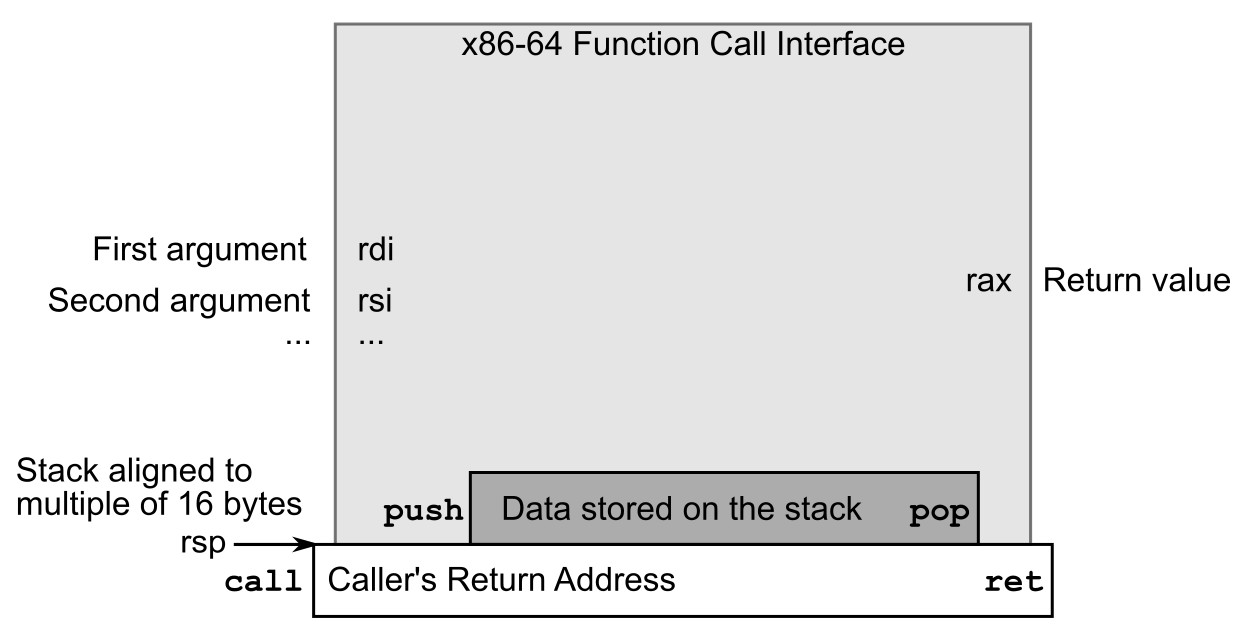The
instruction "call" is used to call another function. A
called function can then return using "ret".
By default, the assembler assumes functions you call are defined later in the same file. To call an external function, such as NetRun's "print_long", or a standard C library function like "exit", you need to tell the assembler the function is "extern". "extern" isn't actually an instruction--it doesn't show up in the disassembly--it's just a message to the assembler (often called a pseudoinstruction). In C++ or C, header files tend to contain declarations of external functions, and so play the same role as extern in the assembler.
Here's how
we'd call the UNIX function "exit",
which ends the program:
extern exit ; tell assembler function is defined elsewhere call exit ; call the function
Here's how
we'd call the standard C library function "getchar",
which reads one ASCII character from cin, and returns it in rax.
extern getchar call getchar ret
push rdx ; align stackTo show integers, "print_long" takes one long integer in rdi, and prints it on the screen:
extern read_input call read_input ; rax has the read-in integer now add rax,10000
pop rdx ; clean up stack
ret
push rdx ; align stack
mov rdi, 17 ; function argument goes into print_long in rdi extern print_long call print_long
pop rdx ; clean up stack ret

push rdx ; align stack
mov rax, 5 ; I hope to return this mov rdi, 3 ; function argument for print_long extern print_long call print_long ; CAUTION: print_long trashed our rax!
pop rdx ; clean up stack ret
The solution
is to save our register on the stack before calling a function
that might trash it.
mov rax, 5 ; I hope to return this push rax ; save it on the stack (also aligns the stack) mov rdi, 3 ; function argument for print_long extern print_long call print_long ; CAUTION: print_long trashed rax!
pop rax ; restore our rax (and clean up stack) ret
(Try this in NetRun now!)
Summary of the rules for calling functions on Linux x86-64:
Your function also obeys these rules!
A function defined in assembly looks just like a jump label, but then ends with a "ret". Here's an example:
mov rdi,7 ; pass a function parameter call otherFunction ; run the function below, until it does "ret" add rax,1 ; modify returned value ret otherFunction: ; a function "declaration" in assembly mov rax,rdi ; return our function's only argument ret
Notice how a
function declaration in assembly looks exactly like a goto
label. The only real difference is you can get back from a
function by calling "ret" to return to whoever called you.
If you mix up
call / ret and jmp / jmp, often parts of your code will get
skipped over. For example, if we replace "call
otherFunction" with "jmp otherFunction", then otherFunction's ret
will return all the way back to main, and we never do the add.
| Getting There |
Getting Back |
|
| function |
call somewhere |
ret * |
| goto |
jmp somewhere |
jmp backToYou |
By default,
functions you declare in assembly are only visible in your
file. You can make those functions visible from outside
using the "global" directive, another pseudo-instruction like
"extern" (and performing the same sort of operation). In
"Inside a Function" mode, NetRun automatically declares your
function this way, but if you switch to "Whole Functions" mode,
you can take the training wheels off and declare it yourself:
global foo ; make "foo" visible from outside this file foo: ; a function is just a jump label mov rax,3 ret